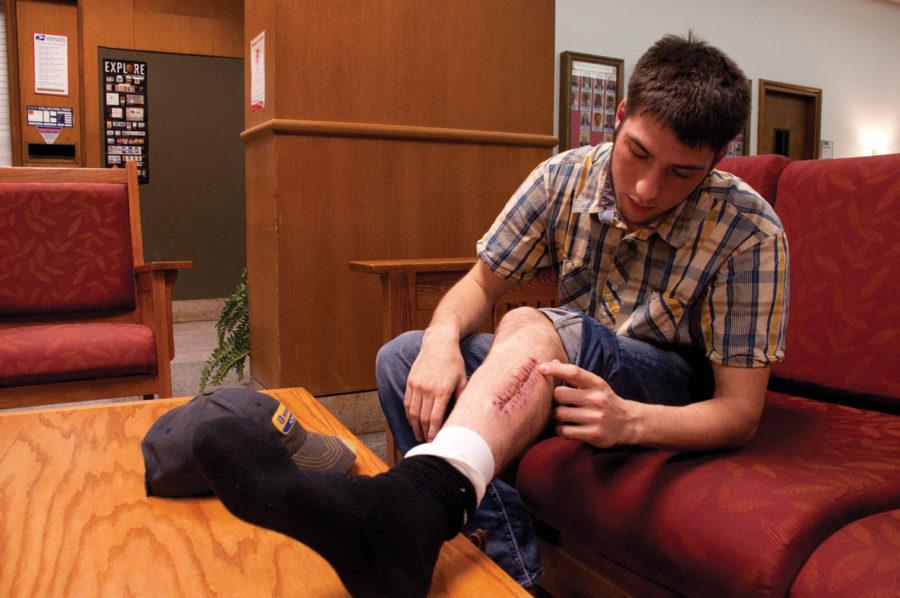Student appreciates blood donations after accidentally shooting himself
March 28, 2011
Most people who experience a gun wound like Marcus Lorimor bleed to death in about two minutes. However, because of his instincts, Marcus is alive today and will forever donate blood.
On March 6 around 12:45 p.m., Marcus was sitting in his car waiting in his driveway for his friend to text him that he was ready to be picked up for a drive to Ames.
“I was messing with my .45 caliber pistol, I took it apart once, put it back together and put my clip back in it, and I was going to take it apart again,” said Marcus, junior in agricultural systems technology. “I had forgotten I had put the clip back in it and loaded a shell in the chamber, so when I was taking off the top of the gun, I pulled the trigger.”
The gun fired and the bullet shot through Marcus’ left thigh.
The bullet had traveled all the way through Marcus’ leg, through his car seat and almost completely through his car door before becoming stuck.
After dropping the gun, opening up the door and falling onto the concrete, Marcus attempted to stop the blood flowing from his wound by immediately putting pressure on the top end of his leg with his elbow, while using his other free hand to call 911 with his cell phone.
Three minutes later, his dad and sister pulled up and saw him lying on the pavement.
“When I first saw him lying next to the car, I thought he had jacked up the car and the car had fallen on him,” said Matt Lorimor, Marcus’ father.
“We drove up, rolled down the window and Marcus said, ‘I messed up,’ and then I saw the pool of blood.”
Mindy Lorimor, Marcus’ sister, was sent inside to retrieve a tourniquet while Matt parked the truck and began to tend to Marcus.
A minute later the deputy showed up, followed by an ambulance five minutes later.
“I remember it being windy and cold, but I was in so much shock that when I actually shot myself it didn’t hurt at all,” Marcus said.
The emergency team worked to get fluid back into Marcus as the helicopter arrived to life flight him to the University of Nebraska Medical Center in Omaha, Neb.
While sitting in the ambulance, Marcus started to wonder if he was going to make it through the accident.
“I looked over to one of the ladies and asked, ‘Am I going to live?'” Marcus said.
Marcus severed his femoral artery, the main artery that runs through the leg. The doctors told Marcus that they don’t see most people who suffer from an injury involving this artery because the victims don’t make it to the hospital.
“I should pretty much be dead right now … that’s how lucky I am,” Marcus said.
Because of Marcus’ instincts, he was able to survive the shot.
“The doctors told me if I wouldn’t have applied pressure, I would have passed out within 30 seconds and would have died in two minutes … I saved my own life,” he said.
Doctors had to operate on the bottom half of his leg to repair the broken artery, by entering on each side of his left calf to sew it back together.
Marcus spent six and a half days in the hospital, received 24 stitches, 26 staples and seven units of blood at $540 per unit.
“An average human contains about 10 to 12 units of blood, and the fact that Marcus needed to replace seven units is a lot,” said Christine Hayes, vice president of communications for Life Serve Blood Center.
“I have never donated blood before, but after this experience, I always will to return the favor for those who help me,” Marcus said.
Marcus isn’t the only one who has had his view changed about donating blood; this incident convinced his dad to begin giving blood as well.
“It showed the importance of giving blood and how crucial giving blood is,” Matt said.
The directors of the ISU Blood Drive believe that by donating blood it helps ensure that blood is there in times of need.
Marcus never thought he would need the blood.
“There is no substitute for human blood, it’s blood or nothing,” said Emily Wade, co-director of the ISU Blood Drive. “In Marcus’ case, he wouldn’t have survived without the seven units of blood other people donated.”
Last year, the ISU Blood Drive had around 2,500 donors, which was a huge increase from previous years.
“At Life Serve Blood Center we keep on stock between 2,500 to 3,000 units of blood every week,” Hayes said.
One donation saves up to three lives, lives just like Marcus Lorimor’s.

















